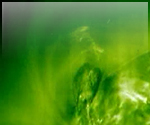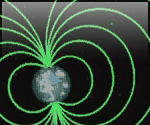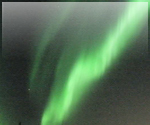

|
Important notice about the deactivation of the STEREO ftp
server
Important notice about the STEREO redirects
Important notice about STEREO Behind
Space Weather
 A solar storm, aurora from space, and aurora on Earth.
A solar storm, aurora from space, and aurora on Earth.
Space weather happens when a solar storm from the Sun travels through space and impacts the Earth’s magnetosphere. Studying space weather is important to our national economy because solar storms can affect the advanced technology we have become so dependent upon in our everyday lives. Energy and radiation from solar flares and coronal mass ejections can:
- Harm astronauts in space
- Damage sensitive electronics on orbiting spacecraft…
- Cause colorful auroras, often seen in the higher latitudes…
- Create blackouts on Earth when they cause surges in power grids.
Understanding the changing Sun and its effects on the solar system,
life, and society is a main goal of NASA's Heliophysics research program.
Many NASA missions focus on the Sun and its interactions with
Earth. Current missions include STEREO, SDO, SOHO, ACE, SORCE, and the Van Allen Probes.
 Check the Current
Space Weather. Check the Current
Space Weather.
Solar Cycle
The changing Sun produces sunspots and solar storms over an 11-year cycle of activity, which is driven by the reversal of its magnetic poles over this time period. Solar storms (coronal mass ejections and flares) occur most often and more powerfully during its period of solar maximum. The current solar maximum is expected to peak in 2012 or 2013.

The Sun in UV changing over 5 years |
|

A century of sunspot number data |
|

Animation: EIT 195 Large (QT, 5.2M)
small (QT, 1.6M) |
Solar Storms
 There are two kinds of solar storms, often related to each other:
coronal mass ejections (CMEs) and solar flares. A flare occurs when
magnetic energy builds to a peak near the Sun's surface and explodes.
This intense, fast-paced event results in an intense burst of light,
including X-rays, in the Sun's lower atmosphere. A much larger storm,
a CME erupts when magnetic field lines snap, sending billions of tons
of material into space at millions of miles per hour. The cloud expands
to over 30 million miles by the time it reaches Earth. Both flares and CMEs
can result in additional high speed particles being shot out into the solar
system at close to the speed of light. There are two kinds of solar storms, often related to each other:
coronal mass ejections (CMEs) and solar flares. A flare occurs when
magnetic energy builds to a peak near the Sun's surface and explodes.
This intense, fast-paced event results in an intense burst of light,
including X-rays, in the Sun's lower atmosphere. A much larger storm,
a CME erupts when magnetic field lines snap, sending billions of tons
of material into space at millions of miles per hour. The cloud expands
to over 30 million miles by the time it reaches Earth. Both flares and CMEs
can result in additional high speed particles being shot out into the solar
system at close to the speed of light.
Impact From Space
One beautiful sign of the space weather at the Earth is the aurora.
When the CMEs from the sun interact with the Earth's own protective
magnetic shield, its magnetosphere, the magnetosphere becomes
disturbed. This ultimately causes charged particles to flow down along
magnetic field lines into the polar regions where they hit the
atmosphere and create the bright aurora. If viewed from high above
Earth, these regions appear as ovals. Images taken by astronauts in the
space shuttles show the depth of aurora. Other impacts from space
weather include short-circuiting power grids that cause blackouts,
disrupting communications, damaging satellites, and endangering
astronauts with radiation.
Aurora
Aurora appear from Earth as shimmering, dancing lights in the night
sky. Only 100 years ago did scientists discover that the Sun was ultimately the
cause of these mysterious lights. Although green is the most common
color, red and yellow hues are also observed. The most powerful
displays occur when large clouds of particles from CMEs slam into our
magnetosphere, but the constant outpouring of solar particles (called
the solar wind) can cause them as well.
Video Clips and Animations

Overview animation of solar storm and its impact on Earth |
|

Extreme close-up of a sunspot in action, Swedish Solar Telescope large (QT, 3.9M), small (QT, 403k) |
|

A particle blast close-up, EIT 304. large (QT, 2.2M), small (QT, 717k) |

Flares and solar activity from late 2003 storms, EIT 195. large (QT, 10.4M), small (QT, 2.6M) |
|

Close-up of a CME blasting off, EIT 195. large (QT, 1.9M), small (QT, 246k) |
|

A busy week of solar activity, LASCO C2 large (QT, 7.2M), small (QT, 2.7M) |

Weeks of solar activity from late 2003 storms, LASCO C3 large (QT, 7.7M), small (QT, 3.8M) |
|

A light-bulb shaped CME, LASCO C3. large (QT, 1.6M), small (QT, 640k) |
|

Solar streaming and CMEs from the Solarmax IMAX film. large (QT, 4.7M), small (QT, 821k) |

Cascades of loops following a flare from TRACE. large (QT, 3.6M), small (QT, 530k) |
|

Cascades of loops following a flare from TRACE. large (QT, 2.6M), small (QT, 359k) |
|

Auroral oval observed from space by IMAGE. large (QT, 2.0M), small (QT, 148k) |

Auroral ovals over the North Pole region from Polar. large (QT, 4.1M), small (QT, 1.7M) |
|

Aurora in UV over both polar regions from Polar. (QT, 2.4M) |
|

NASA animation of Earth's magnetosphere shaped by solar wind (QT, 3.4M) |

Clip of aurora from the Solarmax IMAX film. large (QT, 1.2M), small (QT, 448k) |
Space Weather Poster
Links
Last Revised: Tuesday, 19-Jun-2018 12:03:21 EDT
Responsible NASA Official: ![[email address: therese.a.kucera<at>nasa<dot>gov]](/img/kucera_email.jpg)
Privacy Policy and Important Notices
Accessibility
Webmaster: Apexa Patel
|